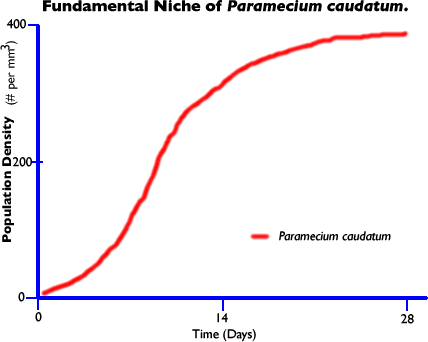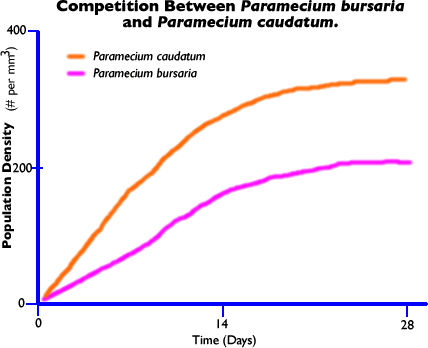 -----
----- 
An ecological niche is mode of existance that a species has within an ecosystem.
Essentially it is the sum of all activities and relationships a species has while obtaining and using the resources needed to survive and reproduce.
A species' niche includes:
a. Habitat - where it lives in the ecosystem
b. Relationships - all interactions with other species in the ecosystem
c. Nutrition - its method of obtaining food.
Fundamental Niche: The fundamental niche is the potential niche, in other words the niche that would prevail in the absence of competition and other factors that might constrain its acquisition and use of the resources.
Realized Niche: The actual niche an organism occupies as a result of competition for its resources, problems in acquiring those resources. The realized niche is always smaller than the fundamental niche!
 -----
----- 
a. 2 Species partially share a niche: both compete in the overlapping parts of the niche for resources, nesting sites, or territory. If the overlap is minimal, both species can coexist.
b. 2 Species have the same niche: both compete head to head in the niche for resources, nesting sites, or territory. One of the species will be superior to the other in utilizing the niche. The 2nd species disappears from the ecosystem.
This is known as the Competitive Exclusion Principle: Only 1 species can occupy a whole niche in an ecosystem at a time.
|
Interaction
|
Examples:
|
|
Herbivory A primary consumer feeds on a producer. |
a. A fruit bat eats a papaya. b. The cottontail eats white clover. |
|
Predation A consumer feeds on another consumer. |
a. The cougar is a predator of black-tailed deer. b. The great white shark is a predator of harbor seals. |
|
Mutualism 2 species live together with each providing benefit to the other via the relationship. |
a. Aphids provide honey dew for ants, while the ants move the aphids to new leaves and protect them from predators. b. The Rufous Hummingbird obtains nectar from the Red Columbine while distributing the pollen for the flower. |
|
Parasitism A parasite lives on or within a host and obtains food from it. The parasite benefits, the host is always harmed. |
a. The fish tapeworm lives in the small intestine of a cat, absorbing digested food provided by the cat. b. Mistletoe is a plant parasite on Oregon White Oak, obtaining sap from the oak. |
|
Competition 2 species compete for the same resource if there is not enough to support both. |
a. Douglas Fir & Western Hemlock grow together in the mixed conifer forests of Oregon, competing for minerals, water, and light. b. A scrub jay and a gray squirrel compete for nuts and seeds within the oak forest. |
Intraspecies Competition: Competition between members of the same species for resources (water, food, shelter and mates) in the habitat.
Interspecies Competition: Competition between 2 different species for the resources of the habitat. Ex: Wolverine fights off a wolf for a dead caribou.